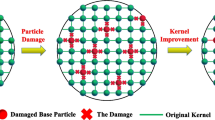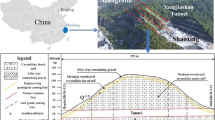Abstract
A large number of shallow-buried tunnels have currently been built in cities, and specific strata, such as thick upper-soft and lower-hard ground layers, are often encountered. For shallow-buried large-span metro tunnels in urban composite strata, it is particularly important to study the effects of rock mass structures on engineering applications; random joint network simulation technology is a suitable method to study this problem. Considering the shallow-buried large-span metro tunnel in Dalian, which is located in a composite stratum, as the engineering background, first, a set of visualizations is developed with a joint network simulation program. The program can also generate several sets of joints and multistratum random joint networks and then combine program-generated data files and UDEC discrete element software-generated random network models. Combined with orthogonal testing, the failure modes of shallow-buried large-span metro tunnels are discussed, and the influences of rock mass structural parameters on tunnel failures are analyzed. The results indicate that the failure modes of all models are shear or tension failure of the overburden strata along weak planes of random joints, which eventually leads to the occurrence of staggered traction slip collapses and clear slip surfaces. This study provides a certain degree of guidance for the deformation and failure of shallow-buried large-span metro tunnels and for the determination of the surrounding rock pressure in urban composite strata.



















Similar content being viewed by others
References
Bidgoli MN, Zhao ZH, Jing LR (2013) Numerical evaluation of strength and deformability of fractured rocks. J Rock Mech Geotech Eng 5(6):419–430
Bieniawski ZT (1989) Engineering rock mass classifications. The Wiley-Interscience Publication, New York
Bonilla-Sieera L, Scholtès F, Donzé V, Elmouttie MK (2015) Rock slope stability analysis using photogrammetric data and DFN-DEM modelling. Acta Geotech 10(4):497–511
Chadwick S (2015) Bond street station upgrade - using 3D analysis to optimise tunnel design. Struct Eng J Inst Struct Eng 93(7):24–26
Cui Z, Leng XL, Zhu ZQ, Sheng Q (2014) Structure effects of random joint network rock mass on seismic response of underground caverns. Rock Soil Mech 35(Sup 2):645–652 (in Chinese)
Cundall PA (1971) A computer model for simulating progressive, large scale movements in blocky rock systems. In: Proceedings of the International Symposium Rock Fracture, ISRM, Nancy, Paper No. II-8, vol. 1
Cundall PA (1980) UDEC-a generalized distinct element program for modelling jointed rock. Report PCAR-1-80, Peter Cundall Associates, European Research Office, US Army Corps of Engineers
Esen Sze YS, Jim Yee TC, Henry Kim I, Osborne NH, Chang KB, Siew R (2016) Tunnelling undercrossing existing live MRT tunnels. Tunn Undergr Space Technol 57:241–256
Fu GY, Ma GW, Qu XL, Huang D (2016) Stochastic analysis of progressive failure of fractured rock masses containing non-persistent joint sets using key block analysis. Tunn Undergr Space Technol 51:258–269
Hartwig ME, Moreira CA (2018) A new computational tool for the follow up of mechanized excavation of tunnels: the case study of the subway line 5-LILAC in São Paulo, Brazil. REM, Int Eng J 71(4):521–529
He S, Li Y, Aydin A (2017) A comparative study of UDEC simulations of an unsupported rock tunnel. Tunn Undergr Space Technol 72:242–249
Hudson JA, Priest SD (1983) Discontinuity frequency in rock masses. Int J Rock Mech Min Sci Geomech Abstr 20(1):73–89
Jia C, Wang ZP, Zhu WS (2011) Program for joint network simulation and its application to dynamic response analysis of underground caverns. Rock Soil Mech 32(9):2867–2872 (in Chinese)
Jiang YJ, Li B, Yamashita YJ (2009) Simulation of cracking near a large underground cavern in a discontinuous rock mass using the expanded distinct element method. Int J Rock Mech Min Sci 46:97–106
Khani A, Baghbanan A, Norouzi S, Hashemolhosseini H (2013) Effects of fracture geometry and stress on the strength of a fractured rock mass. Int J Rock Mech Min Sci 60(8):345–352
Li Y, Jin X, Lv Z, Dong J, Guo J (2016) Deformation and mechanical characteristics of tunnel lining in tunnel intersection between subway station tunnel and construction tunnel. Tunn Undergr Space Technol 56:22–33
Liu Y, Dai F, Xu NW, Zhao T, Feng P (2018) Experimental and numerical investigation on the tensile fatigue properties of rocks using the cyclic flattened Brazilian disc method. Soil Dyn Earthq Eng 105:68–82
Min KB, Jing L (2004) Stress dependent mechanical properties and bounds of Poisson’s ratio for fractured rock masses investigated by a DFN-DEM technique. Int J Rock Mech Min Sci 41:390–395
Nasri V, Haynes CE (2015) New tunnel system to eliminate sanitary sewer overflows and control combined sewer overflows in Hartford, Connecticut. Water Pract Technol 10(2):282–290
Priest SD, Hudson JA (1981) Estimation of discontinuity spacing and trace length using scanline surveys. Int J Rock Mech Min Sci Geomech Abstr 18(3):183–197
Qin CB, Yang XL, Pan QJ, Sun ZB, Wang LL, Miao T (2015) Upper bound analysis of progressive failure mechanism of tunnel roofs in partly weathered stratified Hoek–Brown rock masses. Int J Rock Mech Min Sci 74:157–162
Senent S, Jimenez R (2015) A tunnel face failure mechanism for layered ground, considering the possibility of partial collapse. Tunn Undergr Space Technol 47:182–192
Shang J, West LJ, Hencher SR, Zhao Z (2018a) Geological discontinuity persistence: implications and quantification. Eng Geol 241:41–54
Shang J, Duan K, Gui Y, Handley K, Zhao Z (2018b) Numerical investigation of the direct tensile behaviour of laminated and transversely isotropic rocks containing incipient bedding planes with different strengths. Comput Geotech 104:373–388
The National Standards Compilation Group of People’s Republic of China (2014) GB/T50218–2014 standard for engineering classification of rock masses. China Planning Press, Beijing (in Chinese)
Wang XG, Jia ZX, Zhang FM, Li XQ (2010) The simulation of rock joint network and its application. Water Conservancy and Electricity Publishing House, Beijing (in Chinese)
Wang ZW, Qiao CS, Song CY, Xu JF (2014) Upper bound limit analysis of support pressures of shallow tunnels in layered jointed rock strata. Tunn Undergr Space Technol 43:171–183
Wang TX, Ma WQ, Qu KD (2016) Study of instability mechanism and control of roadway regenerated roof in random joint rock. J Min Saf Eng 33(2):265–270 (in Chinese)
Wu Q, Kulatilake PHSW (2012) REV and its properties on fracture system and mechanical properties, and an orthotropic constitutive model for a jointed rock mass in a dam site in China. Comput Geotech 43:124–142
Xu HF, Chen F, Wang B, Hua ZM, Geng HS (2014) Relationship between RMR and BQ for rock mass classification and estimation of its mechanical parameters. Chin J Geotech Eng 36(1):195–198 (in Chinese)
Zhang ZG, Qiu WG (2015) Discussion and case study of the rational ratio of rock mass thickness and tunnel span of mined subway tunnels in upper-soft and lower-hard ground. Modern Tunn Technol 52(6):28–35 (in Chinese)
Zheng YR (2010) Damage mechanism and design calculation method of tunnel. J Undergr Space Eng 6(S2):1521–1532 (in Chinese)
Acknowledgments
The authors are grateful to Dr. Zhu Ju for his help in revising the paper. Besides, the authors are also grateful to the anonymous reviewers for their careful reading of our manuscript and their many helpful comments.
Funding
This research is sponsored by the Fundamental Research Funds for the Central Universities of China No. C18JB00130 and the National Natural Science Foundation of China under Contract No. 51478031 and the Fundamental Research Funds for the Central Universities of China No. 144484522.
Author information
Authors and Affiliations
Corresponding author
Rights and permissions
About this article
Cite this article
Chen, S., Qiao, C., Yang, Z. et al. Application of stochastic joint network simulation to composite strata of shallow-buried long-span metro tunnels. Bull Eng Geol Environ 79, 2085–2107 (2020). https://doi.org/10.1007/s10064-019-01691-z
Received:
Accepted:
Published:
Issue Date:
DOI: https://doi.org/10.1007/s10064-019-01691-z




